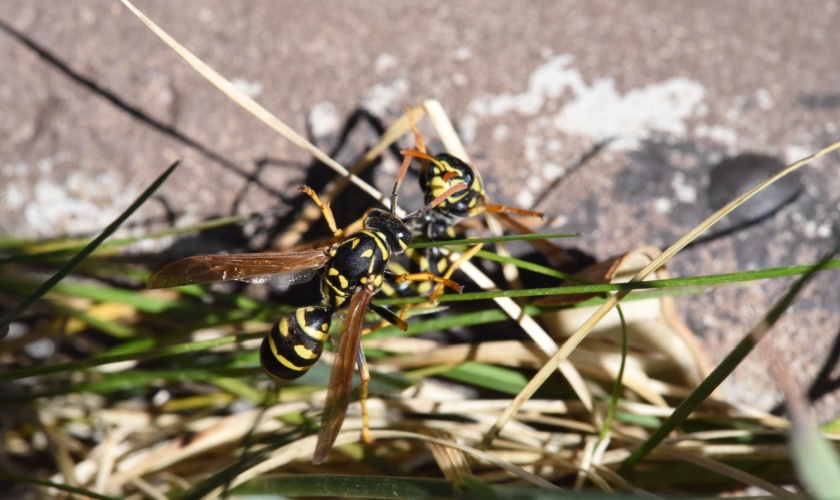Yellow jackets are among the most aggressive stinging insects you can encounter in your yard. Recognizable by their black and yellow striped bodies, these wasps can pose a severe threat, especially if their nest is disturbed. Their stings are not only painful, but can also cause severe allergic reactions in some individuals. If you have a yellow jacket problem in your yard, taking prompt and effective action is crucial. Here’s a comprehensive guide on what to do if you find yourself dealing with these unwelcome guests:
1. Identify the Problem
The first step in dealing with a yellow jacket infestation is to confirm that yellow jackets are indeed the issue. Yellow jackets can be mistaken for other types of wasps or bees, so proper identification is essential.
Signs to Look For:
- Appearance: Yellow jackets have a distinct black and yellow coloration and a smooth body.
- Behavior: They are highly aggressive and are often seen scavenging for food, especially sugary substances and proteins.
- Nesting: Yellow jackets build nests in the ground, inside wall voids, or other protected areas. Look for increased wasp activity around a specific location.
2. Assess the Risk
Before taking any action, assess the risk associated with the yellow jacket nest. Consider the location of the nest and the level of activity. Nests located near high-traffic areas, such as walkways, patios, or play areas, pose a higher risk.
Considerations:
- Allergic Reactions: If anyone in your household is allergic to wasp stings, the presence of yellow jackets is particularly dangerous.
- Children and Pets: The safety of children and pets should be a priority. Yellow jackets can be aggressive if they feel threatened.
3. Avoid Provoking the Wasps
Yellow jackets are highly defensive of their nests and can sting multiple times. To avoid provoking them, maintain a safe distance from the nest and limit activity in the area.
Precautions:
- Stay Calm: Avoid sudden movements that could agitate the wasps.
- Restrict Access: Keep children and pets away from the nest area.
4. Determine Your Approach
Decide whether you want to handle the problem yourself or hire a professional pest control service. While DIY methods can be effective for small nests, larger infestations or nests in difficult-to-reach areas are best left to professionals.
5. DIY Methods
If you choose to tackle the problem yourself, several methods can help eliminate yellow jackets. Always prioritize safety and wear protective clothing.
Methods:
- Commercial Wasp Sprays: These sprays are designed to kill wasps on contact and can be used from a safe distance. Apply the spray at night, when the wasps are less active.
- Wasp Traps: These traps use bait to lure yellow jackets and capture them. Place traps away from high-traffic areas to divert the wasps.
- Soapy Water Solution: A mixture of water and dish soap can be sprayed on the nest. The soap clogs their breathing pores, killing them. Use this method with caution and apply it at night.
6. Professional Pest Control
For larger infestations or nests in hard-to-reach places, hiring a professional pest control service is the safest and most effective option. Professionals have the knowledge, experience, and equipment to handle yellow jackets safely.
Benefits:
- Expertise: Professionals can accurately assess the situation and determine the best course of action.
- Safety: They have the necessary protective gear and tools to safely remove the nest.
- Long-term Solutions: Professionals can provide advice on preventing future infestations.
7. Prevent Future Infestations
Once the yellow jackets are eliminated, take steps to prevent them from returning.
Preventative Measures:
- Seal Entry Points: Inspect your home and yard for potential nesting sites and seal any cracks or holes in walls, eaves, and the ground.
- Remove Food Sources: Yellow jackets are attracted to food, especially sugary substances. Keep garbage cans tightly sealed and clean up spills promptly
- Maintain Landscaping: Trim back shrubs and bushes, and keep your yard free of fallen fruit and other debris that can attract yellow jackets.
8. Monitor the Area
After removing the nest and taking preventative measures, continue to monitor the area for any signs of yellow jacket activity. Early detection can help prevent another infestation.
Tips:
- Regular Inspections: Periodically check common nesting sites around your yard.
- Traps: Consider using yellow jacket traps as a preventative measure, especially during peak activity seasons.
9. Educate Yourself and Others
Understanding yellow jacket behavior and the risks associated with them can help you take appropriate actions and educate others about safety measures.
Educational Resources:
- Local Extension Services: Many local agricultural extension services offer information on pest control.
- Online Resources: Numerous websites and online forums provide tips and advice on dealing with yellow jackets.
10. Stay Prepared
Even after dealing with an infestation, it’s wise to stay prepared for the possibility of yellow jackets returning. Keep necessary supplies on hand and remain vigilant during the warmer months, when yellow jackets are most active.
Preparation Tips:
- Stock Up on Supplies: Keep a supply of wasp spray and traps available.
- Emergency Plan: Have a plan in place in case of a severe allergic reaction, including access to an epinephrine auto-injector if needed.
Citra Pest Can Eradicate Your Yellow Jackets
Dealing with a yellow jacket problem in your yard can be daunting, but with the right approach and precautions, you can effectively eliminate these aggressive pests and protect your family. Whether you choose to handle the problem yourself or hire a professional like Citra Pest Control, the key is to act promptly and safely. By taking preventative measures and staying vigilant, you can enjoy your outdoor spaces without the threat of yellow jackets.
